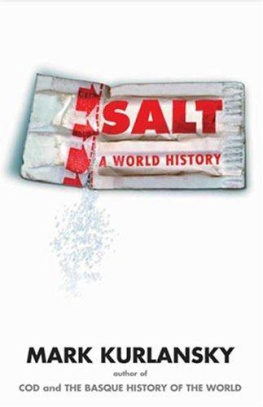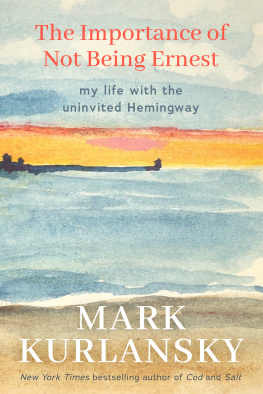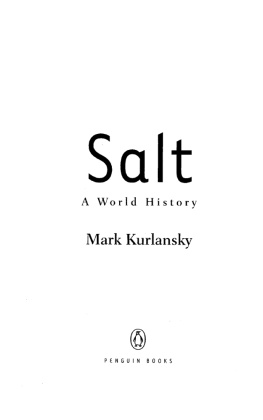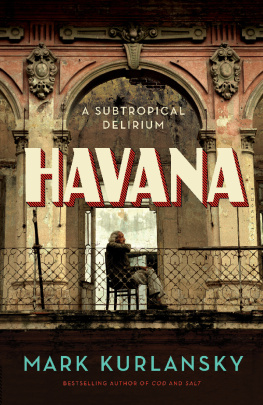Mark Kurlansky - Salt: A World History
Here you can read online Mark Kurlansky - Salt: A World History full text of the book (entire story) in english for free. Download pdf and epub, get meaning, cover and reviews about this ebook. genre: Detective and thriller. Description of the work, (preface) as well as reviews are available. Best literature library LitArk.com created for fans of good reading and offers a wide selection of genres:
Romance novel
Science fiction
Adventure
Detective
Science
History
Home and family
Prose
Art
Politics
Computer
Non-fiction
Religion
Business
Children
Humor
Choose a favorite category and find really read worthwhile books. Enjoy immersion in the world of imagination, feel the emotions of the characters or learn something new for yourself, make an fascinating discovery.
- Book:Salt: A World History
- Author:
- Genre:
- Rating:5 / 5
- Favourites:Add to favourites
- Your mark:
- 100
- 1
- 2
- 3
- 4
- 5
Salt: A World History: summary, description and annotation
We offer to read an annotation, description, summary or preface (depends on what the author of the book "Salt: A World History" wrote himself). If you haven't found the necessary information about the book — write in the comments, we will try to find it.
Salt: A World History — read online for free the complete book (whole text) full work
Below is the text of the book, divided by pages. System saving the place of the last page read, allows you to conveniently read the book "Salt: A World History" online for free, without having to search again every time where you left off. Put a bookmark, and you can go to the page where you finished reading at any time.
Font size:
Interval:
Bookmark:

I N 1666, THE Saltzburg Chronicle described the following incident:
In the year 1573, on the 13th of the winter month, a shocking comet-star appeared in the sky, and on the 26th of this month a man, 9 hand spans in length, with flesh, legs, hair, beard and clothing in a state of non-decay, although somewhat flattened, the skin a smoky brown color, yellow and hard like codfish, was dug out of the Tuermberg mountain 6300 shoe lengths deep and was laid out in front of the church for all to see. After a while, however, the body began to rot and was laid to rest.
He was found by salt miners in the Drnberg mountain mine near the Austrian town of Hallein, a name which means saltwork, near Salzburg, which means salt town. The perfectly preserved body, dried and salted like codfish, was that of a bearded man with a pickax found near him, evidently a miner, wearing pants, a woolen jacket, leather shoes, and a cone-shaped felt hat. The bright colors of the patterned clothingplaid twill with brilliant redwere striking, not only because of how well the salt conserved the colors but also because Europeans are not thought of as people dressed in such a flaming palate. In 1616, a similar body had been found in nearby Hallstatt, which also means salt town.
Inside these alpine mountains of salt, the weight of the rock overhead causes walls to shift, opening cavities and closing up shafts. Water running over the rock salt turns to brine, which then crystalizes, sealing over cracks. Three prehistoric miners have been found, trapped in their dark ancient work sites, and many tools, leather shoes, clothes in their original bright colors the oldest color-preserved European textiles ever foundleather sacks for hauling rock salt on their backs, torches made of pine sticks bundled together and dipped in resin, and a horn possibly used to warn of cave-insall well preserved in salt. The bodies were dated to 400 B.C., but some of the objects found in the remains of a log cabin thatched-roof village on the mountainside may date back to 1300 B.C.
The colorfully dressed salt miners of Hallein were Celts. Celts did not illustrate their culture on temple walls as the Egyptians did; nor did they have chroniclers as the Greeks and Romans did. The guardians of Celtic culture, the Druids, did not leave written records. So most of what we know of them is from Greek and Roman historians who described the Celts as huge and terrifying men in bright fabrics. Aristotle described them as barbarians who went naked in the cold northern weather, abhorred obesity, and were hospitable to strangers. Diodorus, a Greek historian who lived in Sicily, wrote: They are very tall in stature, with rippling muscles under clear white skin. Their hair is blond, but not naturally so. They bleach it, to this day artificially washing it in lime and combing it back from their foreheads. They look like wood demons, their hair thick and shaggy like a horses mane. Some of these are clean shaven, but othersespecially those of high rank, shave their cheeks but leave a moustache that covers the whole of the mouth and, when they eat and drink, acts like a sieve, trapping particles of food.
It is a sad fate for a people to be defined for posterity by their enemies. Even the name, Celt, is not from their own Indo-European language but from Greek. Keltoi, the name given to them by Greek historians, among them Herodotus, means one who lives in hiding or under cover. The Romans, finding them less mysterious, called them Galli or Gauls, also coming from a Greek word, used by Egyptians as well, hal, meaning salt. They were the salt people. The name of the town that sits on an East German salt bed, Halle, like the Austrian towns of Hallein, Swbisch Hall, and Hallstatt, has the same root as do both Galicia in northern Spain and Galicia in southern Poland, where the town of Halych is found. All these places were named for Celtic saltworks.
Their land was in what is now Hungary, Austria, and Bavaria. The Rivers Rhine, Main, Neckar, Ruhr, and Isar are all thought to have been named by the Celts. Like the ancient Chinese emperors, they based their economy on salt and iron and so needed waterways to transport their heavy goods.
The Celts used rivers for trade and conquest. They moved west into France, south into northern Spain, and north into Belgium, named after a Celtic tribe, the Belgae. At the time that the mine shaft trapped the miner in Drnberg, Celts were moving into the British Isles and the Mediterranean. In 390 B.C., the Celts sacked Rome, having traveled eighty miles in four days on horseback in an age when western Europeans had not seen mounted cavalry. They terrorized townspeople with their heavy swords and loud war cries. The Celts controlled Rome for the next forty years, and in 279 B.C., they invaded what is now Turkey.
Exactly how far in the world they traveled, settled, and traded is not certain. Until the nineteenth century, Western history generally dismissed the Celts as crude and frightening barbarians. But in 1846, a mining engineer named Johann Georg Ramsauer began looking for pyrite deposits in the area of the Hallstatt salt mine near Hallein. Instead he found two skeletons, an ax, and a piece of bronze jewelry. Then he discovered seven more bodies buried with valuables. He reported his findings to the government in Vienna and received funding from the curator of the imperial coin collection to continue digging. In one summer he found another 58 graves. In sixteen years he found 1,000 graves, both burials and cremation urns, and carefully cataloged thousands of objects. Numbering each grave, an artist made a watercolor record of the bodies and artifacts at each site. Ramsauers meticulous scientific methodology made him a pioneer in the new science of archaeology. In the process, a great deal was learned about the early salt-trading Celts. The Hallstatt Period became the archaeological name for a rich early Iron Age culture, beginning about 700 B.C. and lasting until 450 B.C.
Ramsauers Hallstatt graves were mostly from 700 to 600 B.C. , with some as late as 500 B.C. The Drnberg discoveries from 400 B.C. suggest that the Hallstatt mine began to diminish in importance as the Drnberg one became a more important source of salt.
Ramsauers dig and the Drnberg finds showed a society living off of salt mining, secluded on remote and rugged mountains at an altitude of 3,000 feet, and yet trading to the far ends of the continent. These people were buried with valuable possessions from the Mediterranean, from North Africa, even from the Near East. Ramsauers investigation of these salt miners began to challenge the perception of northern Europes Iron Age barbarians.

ONLY IN THE 1990s did Westerners become aware of the mummies that had been found in the Uyghur Autonomous Region of China. They had been discovered in and near the Tarim Basin, west of Tibet, east of Samarkand and Tashkent, between China and central Asia along the Silk Road, the principal trade route between the Mediterranean and Beijing. It was the road of Marco Polo, but these people had lived more than three millennia earlier, about 2000 B.C. As with the early Egyptian burials that are 1,000 years older, the corpses had been preserved by the naturally salty soil.
The condition of the bodies and their bright colored clothing was spectacular. The men wore leggings striped in blue, ochre, and crimson. They appeared to be tall with blond or light brown hair, sometimes red beards, and the womens hair woven in long blond braids. These unknown people were in appearance notably similar to the large blue-eyed blond Celtic warriors described by the Romans almost two millennia later. Their conical felt hats and twill jackets bore a close resemblance to those of the salt miners in Hallein and Hallstattnot unlike the much later plaids of the Scottish Highlands. The red-and-blue pinstripes were almost identical to fabrics found in the Drnberg mine. Textile historian Elizabeth Wayland Barber concluded that even the weave was nearly identical workmanship. Why Celts might have been in the salty desert of Asia many centuries before there were known to be Celts remains a mystery.
Next pageFont size:
Interval:
Bookmark:
Similar books «Salt: A World History»
Look at similar books to Salt: A World History. We have selected literature similar in name and meaning in the hope of providing readers with more options to find new, interesting, not yet read works.
Discussion, reviews of the book Salt: A World History and just readers' own opinions. Leave your comments, write what you think about the work, its meaning or the main characters. Specify what exactly you liked and what you didn't like, and why you think so.









